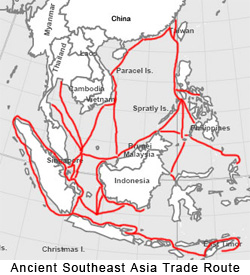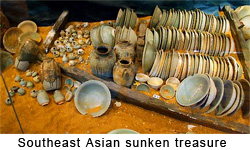|
PRINCIPLES
OF COLLECTING ASIAN CERAMICS:
Buy
in Emerging Asian Countries,
if
you can endure it.
Probably the least obvious region to buy Chinese (and other Asian)
Ceramics is in the less developed countries of Southeast Asia. To understand the reasons behind this, it is important to first understand the history of the region.
 Trade within Southeast Asia has existed since the Han dynasty (25BC - 220AD) and has continued with some interruptions -- to this day. Silk and cotton fabrics, advanced metal weapons and tools, and elegant
Porcelain and Stoneware Ceramics are a few of the multitude of luxury goods from China that were traded over the 2,000 year period. Trade within Southeast Asia has existed since the Han dynasty (25BC - 220AD) and has continued with some interruptions -- to this day. Silk and cotton fabrics, advanced metal weapons and tools, and elegant
Porcelain and Stoneware Ceramics are a few of the multitude of luxury goods from China that were traded over the 2,000 year period.
The tribal kings and other elite of countries like Indonesia,
Philippines, Malaysia and Vietnam had great desire for advanced Chinese goods. In addition, the sizeable communities of Chinese emigrants that developed over the centuries also naturally had
desire for high-quality Ceramics and other products from their homeland.
Of all the goods traded, Porcelain and other glazed Ceramics are today
considered foremost among these for the simple reason that they
are the only ones that survived. Ceramics can emerge in mint
condition despite being buried for centuries underwater or
underground -- unlike virtually all other
traded goods and art mediums. We would have lost much of our understanding of ancient Asian civilizations had they chose a less
durable material for their art.
Chinese (and other Asian) ceramic items were revered by the people of Southeast Asia and given almost holy status. As a result, more of it has survived to the present day than
in China itself. Porcelain, Celadon and other glazed Ceramics were handed down from generation to generation or enclosed in tombs.
Artefacts were also preserved in the many shipwrecks that occurred over the centuries in the regions
violent tropical storms.
 As a result of its history, many countries in Southeast Asia developed an
inventory of ancient Porcelain, Stoneware and even attractive Earthenware
Ceramics that can be acquired by modern collectors. As a result of its history, many countries in Southeast Asia developed an
inventory of ancient Porcelain, Stoneware and even attractive Earthenware
Ceramics that can be acquired by modern collectors.
This situation is made better for collectors since these countries have not (until recently)
been an export destination for dealers in Chinese
fakes.
Further, countries like Indonesia and Philippines never developed indigenous
glazed Ceramics traditions and so there are fewer potters with
the skills to be able to make modern fakes.
Thailand and Vietnam, on the other hand, did develop
the skills to produce glazed and intricately decorated Porcelain
and Stoneware.
This was probably the result of Chinese potters who relocated to
the countries. As a result, modern fakes are more common
in these 2 countries since some can be produced locally.
The downside to this mainly happy situation is that collecting
Ceramic Art in emerging countries is difficult. A lot of
time and tremendous aggravation
is required to find reputable dealers and price negotiations are
convoluted and painful.
And finally, Chinese fakes are starting to appear in shop windows in
greater numbers and the authentic pieces remaining will almost
certainly soon be overwhelmed with them.

Go to the
Chalre
Collection
of
Asian Ceramic Art

|